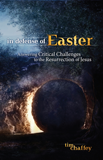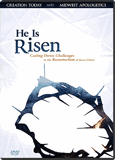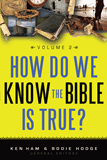
Mistaken or Stolen Identity?
Tim Chaffey, AiG–US, critiques three alternate explanations for the Resurrection that make little effort, if any, to deal with the texts of Scripture or the “minimal facts.”
We have previously addressed the “infallible proofs” and other evidences, including the “minimal facts,” for the Resurrection of Jesus. As we have seen, if Jesus rose from the dead, then He is precisely who He claimed to be: the Son of God and the only Way to the Father (Matthew 16:16–17; John 14:6).
We have also seen that the teaching of the Resurrection was so central to the early church’s message that the Christian faith truly stands or falls with the Resurrection. As such, critics and skeptics have relentlessly attacked this event. They have developed scores of alternate theories in their efforts to explain away the facts, since believing God raised Jesus from the dead is unacceptable to them. The most popular of these theories will be examined in forthcoming articles. Presently, we will critique three alternate explanations for the Resurrection that make little effort, if any, to deal with the texts of Scripture or the “minimal facts.”
Mistaken Identity
One of the more popular arguments against the Resurrection of Jesus, particularly in Islamic circles, is derived from the Qur’an, which states the following:
That they said (in boast), “We killed Christ Jesus the son of Mary, the Messenger of Allah”—but they killed him not, nor crucified him, but so it was made to appear to them, and those who differ therein are full of doubts, with no (certain) knowledge, but only conjecture to follow, for of a surety they killed him not—nay, Allah raised him up unto Himself; and Allah is Exalted in Power, Wise. (Qur’an, 4:157–158, Yusuf Ali)1
In other words, the Qur’an teaches that Jesus did not even die on the Cross. Instead, Muslims believe that at or around the time of His arrest, Jesus was taken to heaven while one of His disciples, probably Judas, was transformed to look just like Him. So this disciple was arrested, beaten, and crucified in His place.
There are multiple problems with this statement in the Qur’an. First, this passage refers to Jews who rejected “Christ Jesus” and claimed to have crucified Him. Many people today assume that Christ is part of the name of Jesus, and it seems that Muhammad believed this too, but it is actually the Greek word for Messiah (Hebrew mashiyach). So rather than being a first name (or a last name), Christ is a title identifying Jesus as the Jewish Messiah, and non-Christian Jews would never identify Jesus as the Messiah. And if they did think of Him that way, they never would have boasted about crucifying Him. Second, these same Jews would not have used the phrase “messenger of Allah.” Allah is not the same as Yahweh, the God of the Bible, and these Jews did not believe Jesus was “the Messenger of Allah.” Third, this passage poses a theological problem for Muslims because it shows Allah as a deceiver who tricked people into thinking they had crucified Jesus. If Allah is a deceiver, how could anything in the Qur’an be trusted as being true? Finally, this passage denies that Jesus died by crucifixion, yet this is the first of the five key evidences accepted by the vast majority of scholars. The biblical writers affirm Jesus was crucified, as did several non-Christian writers in the first century after His death, including the Jewish historian Josephus and the Roman historian Tacitus. Bear in mind that the Qur’an was not written until the seventh century AD.
Further support for this case of mistaken identity is also drawn from a book known as the Gospel of Barnabas (GoB), not to be confused with the Epistle of Barnabas (late first century). According to the GoB, Jesus was taken to the third heaven by angels just before the soldiers and Judas arrived to arrest Him, and then the following event took place:
Judas entered impetuously before all into the chamber whence Jesus had been taken up. And the disciples were sleeping. Whereupon the wonderful God acted wonderfully, insomuch that Judas was so changed in speech and in face to be like Jesus that we believed him to be Jesus… And as he was saying this the soldiery entered, and laid their hands upon Judas, because he was in every way like to Jesus. (Gospel of Barnabas, 216)
As with the Qur’an, there are several problems with this passage. It is readily apparent that the book is not an ancient document composed by the Apostle Barnabas. Instead, it is a sixteenth century forgery and was drafted to promote Islamic claims about the Bible and Jesus. For example, the book repeatedly attempts to show that Muhammad is superior to Jesus, and it reflects an Islamic understanding of Jesus. Ironically, the introduction of the book states that “the great and wonderful God hath during these past days visited us by his prophet Jesus Christ in great mercy …” (emphasis added). Yet in chapter 42 of this forgery, Jesus, echoing lines from John the Baptist in the Bible, specifically denies being the Messiah, which anyone with an elementary understanding of Hebrew and Greek would immediately recognize as a denial of being the Christ, since as mentioned earlier, the terms Messiah and Christ are synonymous.2
Every quotation of the Old and New Testament in the GoB is from the Latin Vulgate (c. AD 400) and it even contains quotations of the Italian poet Dante (c. 1265–1321). The book also contains numerous historical and geographical errors, such as the claim that Jesus sailed on the Sea of Galilee to Nazareth (GoB, 20), but Nazareth is about 15 miles away from that body of water and cannot be reached via water. This forgery also states that Jesus was born while Pilate was governor (GoB, 3), but he actually became governor around AD 26 or 27, about the time Jesus began His ministry. It refers to Barnabas as one of the original 12 disciples and even has Jesus, during His ministry, address him as Barnabas. But Barnabas was not one of the original 12 disciples. And even if he had been one of them, he would have been known at that time by his birth name, Joseph, since he wasn’t nicknamed Barnabas, which means “son of encouragement,” until he sold a field and gave the proceeds to the apostles (Acts 4:37).
The mistaken identity view has zero textual support from any early writers and contradicts the first key evidence—Jesus died by crucifixion. It requires an act of deception by the god who supposedly performed the miraculous transformation of the disciple to look like Jesus, so the deity who allegedly wrought this miracle would be a deceitful being, and therefore certainly not worthy of anyone’s trust.
Legend
In our second article in this series, it was mentioned that some skeptics and critics claim that the beliefs about Christ’s Resurrection were simply legends that developed over decades as Christianity spread throughout the Roman Empire. Dan Barker, a former pastor, well-known skeptic, and copresident of the Freedom from Religion Foundation, is one of those who has touted the legend view.
There have been many reasons for doubting [Jesus rose bodily from the grave], but the consensus among critical scholars today appears to be that the story is a “legend.” During the 60–70 years it took for the Gospels to be composed, the original story went through a growth period that began with the unadorned idea that Jesus, like Grandma, had “died and gone to heaven” and ended with a fantastic narrative produced by a later generation of believers that included earthquakes, angels, an eclipse, a resuscitated corpse, and a spectacular bodily ascension into the clouds.
The earliest Christians believed in the “spiritual” resurrection of Jesus. The story later evolved over time into a “bodily” resurrection.
Barker attempts to support his proposal by listing the number of “Extraordinary Events” described by the various biblical writers in their respective Resurrection narratives—he also throws into the mix the non-canonical and sometimes bizarre work called the Gospel of Peter. He counts the number of events he considers to be extraordinary with a date he assigns to each of the writings and claims that the number of these events increases as time passes, showing that the legend grew as time went on.
There are multiple problems with Barker’s claims and the legend view in general. Barker, like other proponents of this view, does not even attempt to account for the evidence described in our previous article. While these people may accept that Jesus died on a cross, they deny that the disciples, Paul, and James believed that Jesus appeared to them, and they reject the empty tomb. So those who cling to the legend view are at odds with practically all historians. Let’s take a look at some of Barker’s specific errors. Here is a chart illustrating his claims.
| Skeptic Dan Barker’s List of Extraordinary Events in the Resurrection Accounts | |||
|---|---|---|---|
| Writer | Date | Resurrection Passage | Extraordinary Events |
| Paul | 50–55 | 1 Corinthians 15:3–8 | 0 |
| Mark | 70 | Mark 16 | 1 |
| Matthew | 80 | Matthew 28 | 4 |
| Luke | 85 | Luke 24 | 5 |
| Peter | 85–90 | Gospel of Peter fragment | 6 |
| John | 95 | John 20–21 | 8+ |
First, the dates Barker assigns to each of the writings other than 1 Corinthians are highly unlikely. Of course, he opts for dates consistent with the critical theologians who have sought to “demythologize”3 the Scriptures. But there are excellent reasons for rejecting these dates. For example, Luke wrote his Gospel prior to writing Acts, and there are strong indications that Acts was penned several years before Paul’s execution (c. AD 66).4 In fact, most orthodox, Bible-believing scholars have assigned a date prior to AD 70 to all of these writings except the Gospel of John and the Gospel of Peter.
Second, even if we grant the unlikely dates used by Barker, his methodology contains serious mistakes. He ignores the various reasons why the authors wrote what they did and presumes that each of the authors attempted to provide an exhaustive account of post-Crucifixion events. This is clearly not the case, since in 1 Corinthians 15:3–7 Paul recited an earlier creedal statement dating to within a few years of the Resurrection. Creeds are not meant to provide every detail available. Instead, they are designed to be succinct summaries of essential points. Using Barker’s logic, we should conclude that the drafters of the Nicene Creed did not believe that Jesus performed miracles, although they clearly did, but that was not the point of the creed. In the 1 Corinthians creed, Paul specifically mentioned the death, burial, and Resurrection of Jesus before spending much of the chapter explaining the physical, albeit transformed, resurrection body. Also, each Gospel writer reported certain details that fit his respective purpose.
Barker engages in some peculiar counting to make the number of extraordinary events line up in the order he desires. For example, he does not count Paul’s description of Christ’s appearances in 1 Corinthians 15, but he does count such appearances as extraordinary in Luke and John. This is because Barker sets himself up as the one who gets to determine what qualifies as extraordinary. Further, he counts the appearance of two angels described in Luke and John as two separate events, even though the appearance of these angels is clearly one event.
Third, Barker’s methodology backfires when we examine other aspects of the accounts to see if there are any signs of legendary development. Consider the amount of eyewitnesses of the risen Christ described in each of these accounts. Mark has an angel telling the women that Jesus was about to appear to the 11 disciples (Mark 16:7). John describes Jesus appearing to 12 people. Matthew reports that Jesus appeared to at least 13 people. Luke mentioned Jesus being seen by at least 15 people. Paul mentions more than 500 eyewitnesses in 1 Corinthians 15.
So, if we were to apply Barker’s methodology to the number of eyewitnesses (and use his dates for the sake of argument), then we would have to conclude that the list in 1 Corinthians 15 is by far the most legendary of these works. And since this passage in 1 Corinthians 15 is part of an early creedal statement dating to within five years of Christ’s death, we should conclude that each of the Resurrection accounts was written earlier—within five years of the events described.5 No scholar would accept such early dates, and these books weren’t written this early; however, this exercise illustrates the obtuseness of Barker’s thinking on the subject.
The legend view fails to make sense of numerous details found in the Scriptures. For example, one of the evidences for the authenticity of the Resurrection accounts is the role played by the women in discovering the empty tomb and being the first witnesses of the risen Savior. If later authors were inventing legendary details to incorporate into the story, they would have never positioned women in such an important role. Josephus, writing at about the same time as the Gospel writers, stated the following concerning the admissibility of women as witnesses: “But let not the testimony of women be admitted, on account of the levity and boldness of their sex.”6 This does not reflect biblical teaching, but was likely taught by the scribes and Pharisees. Wright correctly describes the presence of women in the text.
We do not know (despite repeated scholarly assertions) exactly when the evangelists first put pen to paper. But we must affirm that the story they tell is one which goes back behind Paul, back to the very early period, before anyone had time to think, “It would be good to tell stories about Jesus rising from the dead; what will best serve our apologetic needs?” It is far, far easier to assume that the women were there at the beginning, just as, three days earlier, they had been there at the end.7
The legend view provides a great example of how the various alternatives to the Resurrection might be able to account for certain details in the texts, but they fail miserably when compared to all the data. As such, proponents of these views tend to pick and choose the verses that can be twisted into their scenarios and ignore all of the details that contradict their views.
Copycat
In recent years, a rather novel view has been promoted through a handful of movies and by some of the “new atheists” and “Jesus mythers.” The copycat proposal is similar to the legend view in that it does not even attempt to account for the historical data, so many of the critiques of the legend view are relevant here. Essentially, this idea states that Jesus never really lived, but was invented by the early church who based their ideas about Him on myths of pagan gods from various cultures.
While popularized in movies like The God Who Wasn’t There, Zeitgeist, and Religulous, the copycat view has practically no support among scholars, whether critical or skeptical.8 Historians are virtually unanimous in their belief that Jesus of Nazareth truly lived in the first century AD and is the historical figure behind Christianity.
These arguments were earlier promoted by a former Anglican priest and professor of Greek and New Testament at the University of Toronto. In his book, The Pagan Christ, Tom Harpur garnered his ideas from nineteenth and twentieth century writers Alvin Boyd Kuhn, Godfrey Higgins, and Gerald Massey, who had pushed the idea that virtually all of the main ideas of Christianity and Judaism came from Egyptian religion.
W. Ward Gasque’s research on these men sheds light on the type of “scholarship” we are dealing with here. Consider the fact that Harpur identified Kuhn as an “Egyptologist” who is “one of the single greatest geniuses of the twentieth century,” and a man who “towers above all others of recent memory in intellect and his understanding of the world’s religions.” In reality, Kuhn was a high school language teacher, and neither Kuhn, Higgins, nor Massey appears in Who Was Who in Egyptology or in Pratt’s exhaustive bibliography on Ancient Egypt.9 Simply put, these men are not in any way recognized as experts on ancient Egypt, yet their ideas are being promoted by atheists who are intent on pushing the copycat Messiah myth.
If true, these claims would deal a significant blow to the Christian faith as they would call into serious question the historicity of the life and ministry of Jesus. More importantly, at least as far as this study is concerned, if early Christians simply copied their ideas about the Crucifixion and Resurrection of Jesus from pagan beliefs, then the gospel message would be undermined and we would still be in our sins. Nevertheless, there simply is no warrant for the copycat scenarios.
Pagan Christs
There is no shortage of misinformation from Mythers on this subject. An entire book could be written to counter the false teachings that compare Jesus to other ancient figures. These so-called “saviors” were rarely, if ever, considered to be saviors, although many were considered to be gods, while others were thought to have been miracle workers or magicians. Let’s examine one of these individuals to see if there is any merit in the assertions of the Zeitgeist film. There is little need to offer an additional critique for Religulous since Bill Maher simply copied his claims from Zeitgeist. Also, examining all of the claims would become incredibly redundant since many of the assertions are regurgitated for each “savior” figure.
The following claims are made about the Egyptian god Horus in Zeitgeist:
- He was born of a virgin called Isis Meri (Mary?) on December 25.
- His birth was marked by a star in the east.
- He was adored as an infant by three kings.
- He was a teacher by age 12.
- He was baptized by “Anup the Baptizer” who was subsequently decapitated.
- Horus started his ministry at age 30.
- He had 12 disciples and performed miracles.
- He was known as the “Lamb of God” and “the Light.”
- He was crucified, and lay dead for three days before being resurrected.
Is there any solid evidence for these claims? Absolutely not! In fact, there are good reasons to reject every single point either because it is patently false or because, in many cases even if the claim were true, it would not impact Christianity in any way because the idea is not even found in Scripture.
First, there is no record of Horus being born on December 25. Instead, the only reference that gives a date for his birth places it on day 31 of Khoiak, which roughly corresponds to our month of November. Even if Horus was born on December 25, this would be irrelevant since the Bible never says that this is the date of the birth of Christ.10
Second, no ancient record exists where Isis is called Mary, nor is she ever portrayed as a virgin at the time of the birth of Horus. There is not any record of a star rising in the east at his birth, nor do any ancient records show him being admired by three kings. Once again we see a listing of irrelevant details, which shows that the originators of these falsehoods about connections to Horus have not carefully read the Bible. Even if three kings did visit the infant Horus, it would be irrelevant. The Bible states that magi, not kings, visited Jesus a while after His birth, and it does not tell us how many made the journey.11
Third, no Egyptian records mention Horus being a teacher at age 12, and there certainly is no record of anyone named Anup the Baptizer who later lost his head. In fact, there is never any mention of baptism for Horus. While he did have some followers, there is no indication that he had a select group of 12.
Fourth, Horus was never called “Lamb of God” or “the Light.” However, he did have some titles, such as Great God, Chief of the Powers, Master of Heaven, and Avenger of His Father.12
Finally, Horus certainly was not crucified. This would have been difficult since the first writings about him are from well over a thousand years before crucifixion was even invented. Just as he was not crucified, Horus certainly was never resurrected from the dead as Jesus was.
Mythers have raised similar arguments about many other gods or “saviors,” including Mithra, Zoroaster, Buddha, Krishna, Osiris, Dionysus, and Attus. Yet despite their best efforts, the ancient records of these individuals have very little in common with Jesus, and in some cases, the few similarities in details only arose after the influence of Christian missionaries.
The fact is that the Christian belief in the Resurrection of Jesus did not borrow from any group of people. In many of these “copycat” claims, the common pagan belief regarding an annual dying and rising god symbolizing the changing seasons is absurdly touted as a parallel to the physical death and physical Resurrection of Jesus. As Wright sarcastically noted, “When Paul preached in Athens, nobody said, ‘Ah, yes, a new version of Osiris and such like.’”13
The biblical teaching did not borrow from the Greeks. The notion of bodily resurrection was abhorrent to these people since they viewed the material world as evil. As such, why would anyone desire to undergo physical resurrection?14 This is one of the reasons Paul spent so much time explaining the physical nature of the general resurrection to the Corinthians (1 Corinthians 15). Finally, the Christian belief in Christ’s Resurrection did not even borrow from popular Jewish beliefs of the day, which taught a future bodily resurrection of all people (Daniel 12:2), as indicated by Martha’s response to Jesus in John 11:24.15
Conclusion
So far, we have looked at three of the skeptical attempts to explain away the Resurrection of Jesus. We have seen that each of these positions in their various forms fail miserably in accounting for the details surrounding Christ’s death, burial, and Resurrection. For the most part, these three views (Mistaken Identity, Legend, and Copycat) do not even attempt to interact with the New Testament and other historical data. Instead, their proponents have made outlandish claims without any supporting evidence. And yet, it is often these same proponents who accuse Christians of having blind faith.
Ironically, it is the skeptic who blindly trusts in wild assertions to escape the one thing their belief system fears most: the risen Lord and Savior Jesus Christ. Sadly, instead of humbling themselves and being reconciled to God through faith in Christ, these skeptics mock their Creator and the only means of salvation. If you are one of these skeptics, I urge you to stop trying to justify your unbelief by clinging to these bizarre and unsubstantiated beliefs, repent of your sins, and call upon the risen Lord to save you from your sins.
Footnotes
- Cited by David Wood in “The Irony of the Qur’an—Surah 4:157–158.” Available at http://www.answeringmuslims.com/2008/07/irony-of-quransurah-4157-158.html. Accessed January 16, 2013.
- Indeed it is strange that some Muslim apologists cite the GoB since it clearly contradicts the Qur’an. The GoB specifically denies that Jesus is the Messiah (GoB, 42), reserving that title for Muhammad (GoB, 97), yet the Qur’an calls Jesus the Messiah (Christ) on multiple occasions (e.g., Qur’an 4:171 and 5:75).
- That is, to weed out the mythological elements in the Gospels to ascertain “what really happened.”
- The book of Acts closes with Paul under house arrest in Rome enjoying relative freedom to preach, teach, and receive guests (Acts 28:30–31). In all likelihood, he was going to be set free, since according to Festus, “
He had committed nothing deserving of death,
” nor could Festus make any specific charges against Paul (Acts 25:25–26). After hearing Paul’s defense, King Agrippa agreed with Festus stating, “This man might have been set free if he had not appealed to Caesar
” (Acts 26:32). It was during his time of incarceration in Caesarea and Rome that he wrote the “prison epistles” of Ephesians, Colossians, Philippians, and Philemon. These circumstances are far different than the condition Paul describes at the end of 2 Timothy. Here we find Paul abandoned and fully expecting to be executed (2 Timothy 4:6–16). He implores Timothy to hasten his visit and to bring his cloak (v. 13), indicating that Paul did not enjoy the comforts of his own rented home as he did in Acts 28. For more details about the possibility of Paul’s release from his first Roman imprisonment and his subsequent travels, see Donald Guthrie, New Testament Introduction (Downers Grove, IL: InterVarsity Press, 1996, 4th revised ed.), 622–624, and John William Drane, Introducing the New Testament (Oxford: Lion Publishing, 2000, revised and updated), 365. - For an excellent critique of Barker’s chapter, see David Wood, “A Response to Dan Barker’s ‘Did Jesus Really Rise from the Dead?’” in James Patrick Holding, ed., Defending the Resurrection: Did Jesus Rise from the Dead? (Longwood, FL: Xulon Press, 2010), 81–95.
- Josephus, trans. William Whiston, Antiquities of the Jews, 4.219.
- N.T. Wright, The Resurrection of the Son of God (Minneapolis, MN: Fortress Press, 2003), 608.
- Gary Habermas cited two atheist scholars who have questioned whether or not Jesus was a real person: G.A. Wells and philosopher Michael Martin. See Gary R. Habermas, The Historical Jesus: Ancient Evidence for the Life of Christ, (Joplin, MO: College Press Publishing Company, 1996), 27–45. After examining the claims of these men, Habermas stated, “We have seen that these attempts are refuted at almost every turn by the early and eyewitness testimony presented by Paul and others, as well as by the early date of the Gospels” (p. 45).
- Cited in W. Ward Gasque, “The Leading Religion Writer in Canada … Does He Know What He’s Talking About?” Available at https://hnn.us/articles/6641.html. Accessed October 27, 2012. Dr. Gasque contacted twenty leading Egyptologists and asked them about Kuhn, Higgins, Massey, and their claims. Of the ten scholars who responded, only one had even heard of these men, while all of them rejected their assertions. Gasque concluded, “If one were able to survey the members of the major learned societies dealing with antiquity, it would be difficult to find more than a handful who believe that Jesus of Nazareth did not walk the dusty roads of Palestine in the first three decades of the Common Era. Evidence for Jesus as a historical personage is incontrovertible.”
- For more information on whether or not Jesus was born on December 25th, see Tim Chaffey, “More Christmas Misconceptions—Part Two” at http://midwestapologetics.org/blog/?p=267.
- For more details about the magi and the timing of their visit, see Tim Chaffey, “We Three Kings” at http://www.answersingenesis.org/articles/2010/12/14/we-three-kings. Accessed October 27, 2012.
- J.P. Holding, “Pagan Christ, Egyptian Front: Horus, Osiris,” in J.P. Holding, ed., Shattering the Christ Myth: Did Jesus Not Exist? (Longview, FL: Xulon Press, 2008), 224.
- In his voluminous work on the Resurrection, N.T. Wright examined the dying and rising god cults of antiquity and concluded, “Did any worshipper in these cults, from Egypt to Norway, at any time in antiquity, think that actual human beings, having died, actually came back to life? Of course not.” Wright, Resurrection, 80–81.
- Wright devoted more than 50 pages to examining “the range of options for belief about the dead that were available in the classical world of late antiquity—roughly two or three hundred years either side of the time of Jesus.” He ably demonstrated that the Christian doctrine on Christ’s Resurrection did not borrow from other beliefs. Ibid., 38–39.
- While the Old Testament does contain prophecies concerning the Resurrection of the Messiah (Psalm 16:10; Isaiah 53:8–12), the Jews did not properly understand the details of these passages. Also, some of the teachings about the Messiah implied the Resurrection, such as the ideas that He would have an eternal priesthood (Psalm 110:4; cf. Hebrews 7:25) and that He would physically return to the earth (Zechariah 12:10; 14:4; cf. Acts 1:11).
Recommended Resources

Answers in Genesis is an apologetics ministry, dedicated to helping Christians defend their faith and proclaim the good news of Jesus Christ.
- Customer Service 800.778.3390
- © 2024 Answers in Genesis









